
| myArmoury.com is now completely member-supported. Please contribute to our efforts with a donation. Your donations will go towards updating our site, modernizing it, and keeping it viable long-term.
Last 10 Donors: Anonymous, Daniel Sullivan, Chad Arnow, Jonathan Dean, M. Oroszlany, Sam Arwas, Barry C. Hutchins, Dan Kary, Oskar Gessler, Dave Tonge (View All Donors) |
| Author |
Message |
|
Niels Just Rasmussen
|
 Posted: Wed 20 May, 2015 9:49 am Post subject: Walloon sword ? - Battle of Øksnebjerg 1535, Funen, Denmark. Posted: Wed 20 May, 2015 9:49 am Post subject: Walloon sword ? - Battle of Øksnebjerg 1535, Funen, Denmark. |
 |
|
The battle of Øksnebjerg [older spelling Øxnebjerg] took place 6 km from the town Assens the 11th of June 1535.
Øksnebjerg is actually two hills of 85 and 73 meters, so a place of strategic importance.
It was the place of a critical battle of Grevens Fejde (The Counts Feud) 1534-36 where forces lead by Johan Rantzau won over forces lead by Johann von Hoya (who was killed in the battle).
More history will follow in the next post.
In 1830 a well preserved sword from that battle was found during road construction.
It is at Koldinghus Castle.
It seems to be a Walloon sword with guards perpendicular to the blade and not folded downwards as on a Pappenheimer Rapier. The sword is 88cm long.
According to folklore it belonged to ex-Archbishop Gustav Trolle, but even if this is total speculation it is likely that some high-ranking person in the losing army under von Hoya owned this weapon.
It actually has two bishops chiseled into the blade (the primary cause of ownership speculation, but most likely a weapon carried by the losing catholic supporting forces).
Here is a link with some info in Danish about the weapon and some pictures with hilt details:
Source: https://www.kulturarv.dk/mussam/VisGenstand.action?genstandId=3894007
The sword is interesting with having one open ring and another semi-covered (like walloon and pappenheimer style).
Last edited by Niels Just Rasmussen on Thu 21 May, 2015 10:59 am; edited 5 times in total
|
|
  |
 |
|
Niels Just Rasmussen
|
 Posted: Wed 20 May, 2015 9:53 am Post subject: Posted: Wed 20 May, 2015 9:53 am Post subject: |
 |
|
In 1523 Frederik af Holsten (Frederik I) had taken over the throne of Denmark and Norway from his nephew Christian II.
When he died in 1533 Denmark was thrown into a civil war between those who wanted Christian II back as King and those he wanted the son of Frederik I - Hertug (Duke) Christian (later King Christian III).
It was also a religious war as Christian II was Catholic and Duke Christian Lutheran.
It was known as "Grevens Fejde" and was fought from 1534-1536.
Christian II was supported by Lübeck (mostly for baltic control rather than religious reasons). The Lübeck forces were lead by Count (Danish = Greve, thus the name Grevens Fejde - "The Counts Feud") Christoffer of Oldenburg. He was a grandchild of Danish King Christian I and thus a second cousin to both Christian II and Christian III.
As he landed in Zealand in june 1534 - and was supported by the towns København (Copenhagen) and Malmø - he got control over Zealand, Funen and Scania and was elected Governor of these areas in the name of Christian II.
Duke Christian had his base in Jutland, Slesvig and Holsten, where he was crowned as King Christian III in july 1534.
North Jutland supported Christian II and a peasant army lead by Skipper Clement attacked and took Aalborg. They then crushed a Juttish army of noblemen at Svenstrup oct. 1534.
The leading commander of Christian III's forces was Johan Rantzau, the governor of Slesvig/Holsten. He lead troops north and took Aalborg by storm. Skipper Clement escaped wounded but was later caught (and executed in 1536).
In 1534 Lübeck got into war with Sweden, so the Swedish King Gustav Vasa got allied with Christian III and attacked the Lübeck + Christian II supporting Danish forces in Halland (north of Scania). Lübeck sought support from Albrecht VII of Mecklenburg, who send Graf Johann VII von Hoya with troops to Scania.
Gustav Vasa send more troops into Halland and Scania and the Danish noblemen of Scania chose to support Gustav Vasa rather than the Lübeck forces, all except Tyge Krabbe in Helsingborg Castle.
Lübeck troops and Danish forces from Malmø lead by Borgmester (Mayor) Jørgen Kock arrived at Helsingborg and was in position in front of the town when in in jan. 1535 the Swedish forces and the Danish noblemen of Scania arrived.
Tyge Krabbe then suddenly changed side and directed his cannons to shoot at the Lübeck/Malmø troops and let in the Swedish forces, that totally burned down Helsingborg town.
Christoffer of Oldenburg and Johann von Hoya then hunted down Danish noblemen on Zealand as payment for the treachery of the Scanian noblemen. Their estates were burned and they were send to Mecklenburg as hostages.
Christian III forces lead by Johan Rantzau managed in secrecy to get via Als to Funen and besieged the Lübeck forces at Assens. Johann von Hoya countered with a relief force and the two armies fought at Øksnebjerg in jun 1535. This was a decisive battle were Johann Rantzau won and Johann von Hoya was killed in the battle and the Swedish (former Archbishop of Uppsala) Gustav Trolle was taken prisoner. As catholic he naturally fought against Gustav Vasa and Christian III and for Christian II and his Lübeck allies.
Christian III then got some naval assistance from his brother-in-law Duke Albrecht of Prussia (before converting to Lutheranism he was the last Grandmaster of the Teutonic Order), so a combined Danish-Swedish-Prussian fleet lead by the Dane Peder Skram was able to push the main Lübeck fleet into Copenhagen harbour and destroying another Lübeck fleet at Svendborgsund.
Christian III then himself lead his forces from Funen to Zealand and put Copenhagen under siege july 1535.
In feb 1536 Lübeck sought peace and they recognized Christian III as Danish King.
Malmø capitulated in apr. 1536, but Copenhagen under Borgmester (Mayor) Ambrosius Bogbinder and the fortress Varberg (probably lead by Markus Mejer from Lübeck) in Halland still resisted.
They were hoping for an intervention by Kurfürst Friedrich II, der Weise, von der Pfalz, that was married to Dorethea, the sister of Christian II. His intervention in the Danish war was supported by Habsburg Emperor Karl V.
The Dutch was ordered to prepare a fleet, but then war break out between the Emperor and the French under King François I.
Varberg got conquered and then finally in july 1536 Copenhagen capitulated ended the long siege before the Dutch relief navy was ready. The Copenhagen population was given amnesty and Duke Albrecht of Mecklenburg and Count Christoffer of Oldenburg were allowed to leave the town with their men.
Christian III was now King of Denmark and Norway and the Lutheran Reformation was launched the 30th october 1536.
|
|
  |
 |
Sean Flynt

|
|
   |
 |
|
Niels Just Rasmussen
|
 Posted: Wed 20 May, 2015 10:26 am Post subject: Posted: Wed 20 May, 2015 10:26 am Post subject: |
 |
|
| Sean Flynt wrote: | | At a glance, I'd say that sword post-dates the battle by about 100 years. |
Yeah and when thinking about it the Øksnebjerg sword (see the link on the first post for details) seems to have more of a Walloon ring guard (straight out) than a Pappenheimer type (ring guard curved downwards).
But maybe even with a Walloon guard 1535 might be very early?
The early basket hilted Mary Rose Sword is from 1545, so it is perhaps not totally impossible the Øksnebjerg sword could be from the 1535 battle as complex hilts are starting to be made?!
The pictures I attached first were a mistake (sorry) - these pictures are from a Pappenheimer rapier dated from around 1620-30, so that fits with 100 years later as you said.
 Attachment: 159.36 KB Attachment: 159.36 KB
Pappenheimer Rapier 1620-30 (top) from Koldinghus. [ Download ]
 Attachment: 149.09 KB Attachment: 149.09 KB
Hilt of Pappenheimer rapier 1620-30 from Koldinghus. [ Download ]
Last edited by Niels Just Rasmussen on Wed 20 May, 2015 10:41 am; edited 2 times in total
|
|
  |
 |
Roger Hooper

|
 Posted: Wed 20 May, 2015 10:31 am Post subject: Posted: Wed 20 May, 2015 10:31 am Post subject: |
 |
|
I agree with Sean, that looks like a 17th century campaign sword, and had nothing to do with anything that happened in 1535. It may have some similarities to a Pappenheimer, but Pappenheimers don't have thumb rings, and their side rings are typically tilted. The Walloon name has been used to cover a whole bunch of variations made between 1620 and 1700. Those curlicues where the sidebars meet the side rings echo many Mortuary swords.
This reply is in response to the first post.
|
|
  |
 |
|
Niels Just Rasmussen
|
 Posted: Wed 20 May, 2015 10:52 am Post subject: Posted: Wed 20 May, 2015 10:52 am Post subject: |
 |
|
| Roger Hooper wrote: | I agree with Sean, that looks like a 17th century campaign sword, and had nothing to do with anything that happened in 1535. It may have some similarities to a Pappenheimer, but Pappenheimers don't have thumb rings, and their side rings are typically tilted. The Walloon name has been used to cover a whole bunch of variations made between 1620 and 1700. Those curlicues where the sidebars meet the side rings echo many Mortuary swords.
This reply is in response to the first post. |
Thanks. Not being any kind of expert on these swords I'm happy to learn!
So while more complex hilts starts to be made in the 1500's, this type is much more likely to be from early 1600.
I find the "flattened" pommel on the Øksnebjerg sword quite interesting (swords I see on the net when I search for Walloon or Mortuary swords have rounded pommels).
So perhaps a weapon from the Thirty Year War instead (though weird it is found on Funen and not Jutland as it was only the latter place you have catholic forces invading?).
|
|
  |
 |
Roger Hooper

|
 Posted: Wed 20 May, 2015 11:49 am Post subject: Posted: Wed 20 May, 2015 11:49 am Post subject: |
 |
|
|
Niels, if you want to see some photos of original Walloons, go to this thread
|
|
  |
 |
|
Niels Just Rasmussen
|
 Posted: Wed 20 May, 2015 11:59 am Post subject: Posted: Wed 20 May, 2015 11:59 am Post subject: |
 |
|
It seems very likely now that the weapon must be from the 1600's as I found a Swedish rapier that looks a bit like the Øxnebjerg Sword.
This Swedish sword sold at an auction in Denmark has both an open ring and a semi-closed ring and it also have a flattened pommel and it is dated from the 1600's. So that is the closest I get from doing an internet search....

Source: http://193.238.185.184/images/1836530?size=large&index=1
More images (and bigger) of the sword:
Source: Source: http://www.lauritz.com/en/auction/swedish-rapier/i1836530/
Gustav II Adolf also carried this sword at Lützen (1632), though with more Pappenheimer style ring-guards it also shows a flattened pommel.
Source: http://www.vikingsword.com/vb/attachment.php?...&stc=1
So is this flat pommel something special for Scandinavia?
| Roger Hooper wrote: | | Niels, if you want to see some photos of original Walloons, go to this thread |
Thanks Roger 
Apparently none of the Walloons in this thread come as close as this swedish Sword to the Øksnebjerg sword. For instance none of them have a flattened pommel OR one ring open, the other semi covered.
So if I have to guess the Øksnebjerg sword is perhaps from the 1650's where Swedish troops had invaded Denmark before they were driven out from Funen after the battle of Nyborg in 1659.
|
|
  |
 |
|
Stephen Wheatley
Location: DORSET ENGLAND Joined: 15 Nov 2008
Posts: 93
|
 Posted: Wed 20 May, 2015 3:27 pm Post subject: Oxnebjerg sword Posted: Wed 20 May, 2015 3:27 pm Post subject: Oxnebjerg sword |
 |
|
Yes, it looks like a complex variant of the Swedish/Netherlands hilt of the type widely used in the thirty years war. Beautiful swords. I think the originals were made in Holland then imitated in Gustav Adolf's new factories, not that many pictures of them around, Stockholm's Armeemuseum has a few and the Legermuseum in the Netherlands, I'd love to see more photos of them myself.
Stephen Wheatley
|
|
  |
 |
Roger Hooper

|
 Posted: Wed 20 May, 2015 5:06 pm Post subject: Posted: Wed 20 May, 2015 5:06 pm Post subject: |
 |
|
Here is a photo that I found of early 17th century Swedish cut and thrust swords
 Attachment: 36.54 KB Attachment: 36.54 KB
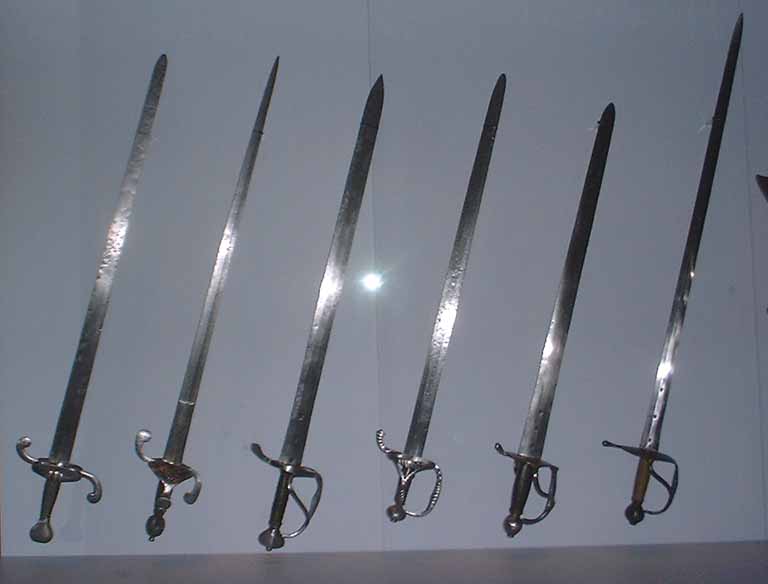
|
|
  |
 |
|
Radovan Geist
|
 Posted: Wed 20 May, 2015 11:40 pm Post subject: Posted: Wed 20 May, 2015 11:40 pm Post subject: |
 |
|
| Niels Just Rasmussen wrote: | So is this flat pommel something special for Scandinavia?
....
So if I have to guess the Øksnebjerg sword is perhaps from the 1650's where Swedish troops had invaded Denmark before they were driven out from Funen after the battle of Nyborg in 1659. |
Hi Nils, I would not say it´s specific for Scandinavia. I would say they´re quite present in German lands. I have seen couple of them on auctions, sometimes with single-edge blades (then they´d call them "German campaign sabre - see the attachment)
In any case, I´d agree that the sword is from a later period, I´d say 1630s - 1650s. But the blade is interesting, I don´t think I´ve seen one like that on this type of swords before.
|
|
  |
 |
|
Niels Just Rasmussen
|
 Posted: Thu 21 May, 2015 10:23 am Post subject: Posted: Thu 21 May, 2015 10:23 am Post subject: |
 |
|
Thanks for your inputs, Stephen, Roger and Radovan.
So very interesting with the info that Gustav II Adolf made Swedish copies of the Dutch "originals". Since they were also used in Germany it seems to be a popular sword for Northern Europe, though still fairly unusual with the flat pommel compared to the bulk of the examples found around Europe.
So they are cavalry swords ? or was used both by infantry and cavalry?
What makes the Øksnebjerg Sword weird is that it has bishops showing it is a “catholic" sword. No Dane nor Swede would ever run around with a papist weapon around the Thirty Years War (unless they had a death wish).
Since catholic forces only occupied Jutland in the Thirty Years War - after Christian IV defeat to Count Tilly at Lutter am Barenberge (1626) - I can't figure out how such a sword could end in the ground on Funen.
A possibility is that when the Swedes occupied Denmark in 1658-1659 (taking all except Copenhagen) they were driven from Funen by a combined Danish-Austrian-Polish/Lithuanian force after their defeat at Nyborg 1659.
An Austrian or Polish-Lithuanian officer might have carried this weapon -> someone retrieved the weapon and buried it at the Old Øxnebjerg battlefield of 1535. [It's unlikely, but still best guess]
But as Øxnebjerg is on the western part of Funen and the battle with the Swedes took part on the Eastern Part of Funen is still not a satisfying explanation - the Danish-Austrian-Polish/Lithuanian forces landed at Kerteminde also in the eastern part of Funen, so there were no fighting or any Swedish troops in the western part.
I think the Bishops-on-the-sword "question" - and being found on the 1535 battlefield - is the reason why the sword got attributed to Grevens Fejde as catholic forces were present there and then.
Then we have Dutch, German, Swedish and perhaps Danish examples of this type - have we any Austrian or Polish/Lithuanian examples, that could support the catholic ownership hypothesis?
|
|
  |
 |
|
J.T. Aliaga
|
 Posted: Thu 21 May, 2015 11:43 am Post subject: Posted: Thu 21 May, 2015 11:43 am Post subject: |
 |
|
Perhaps not bishops depicted but Saints?
Anyhow, I was raised Catholic but I thought some Protestant & Lutheran bishops wore mitres.
|
|
  |
 |
|
Mark Millman
|
 Posted: Thu 21 May, 2015 2:15 pm Post subject: Posted: Thu 21 May, 2015 2:15 pm Post subject: |
 |
|
Dear Niels,
| On Wednesday 20 May 2015, you wrote: | | Apparently none of the Walloons in this thread come as close as this swedish Sword to the Øksnebjerg sword. For instance none of them have a flattened pommel OR one ring open, the other semi covered. |
The Øksnebjerg sword originally had two covered rings, but has lost the plate from its outer ring. Plates of this sort typically were inserted into grooves in the inner surfaces of the side rings and held in place only by spring tension. If you look closely at the second photo on the museum page that you cited (the image with the angled close-up view of the hilt), you can clearly see the groove inside the obverse ring.
Best,
Mark Millman
|
|
  |
 |
|
Stephen Wheatley
Location: DORSET ENGLAND Joined: 15 Nov 2008
Posts: 93
|
 Posted: Fri 22 May, 2015 8:34 am Post subject: Posted: Fri 22 May, 2015 8:34 am Post subject: |
 |
|
Found these on Herman Historica and elsewhere. Most dealers ascribe a Dutch origin although in ''European Swords and Daggers in the Tower of Londo''; - HMSO 1974 - Author Richard Dufty; there's one of these with a gilt representation of what looks very like Gustav Adolf on the shell but with a catholic inscription on the undoubtedly German blade. Unfortunately I cant upload the scan. The last sword illustrated is an English shell-hilt for comparison. Often the complex Swedish hilts approach Walloon - sword construction with the side bar evolving into globular rather than flat guards but still with the characteristic pierced shells. I'll have to get over to Stockholm and seek some out unless some of our Swedish members can do it!
 Attachment: 24.92 KB Attachment: 24.92 KB
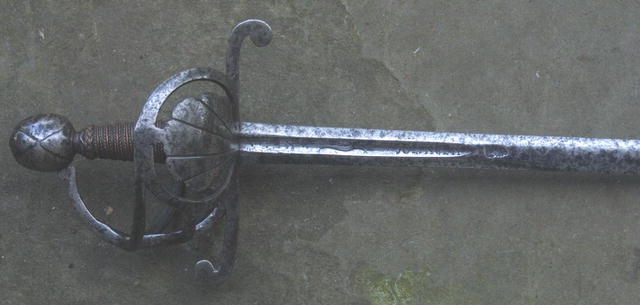
 Attachment: 133.15 KB Attachment: 133.15 KB
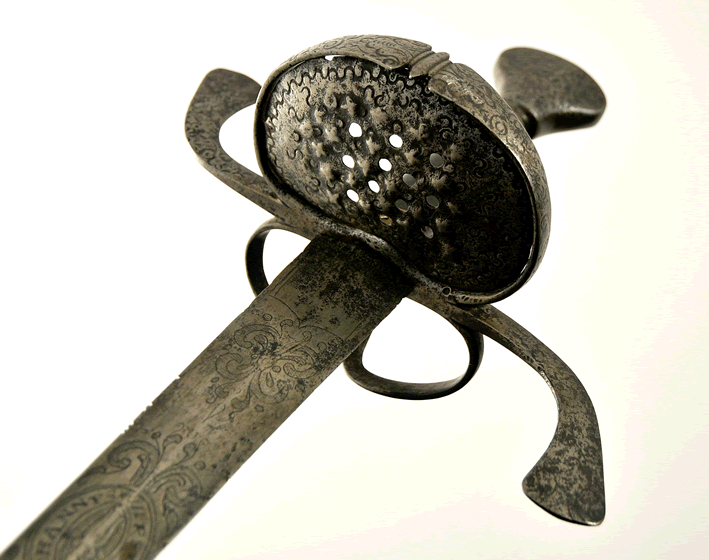
 Attachment: 15.14 KB Attachment: 15.14 KB
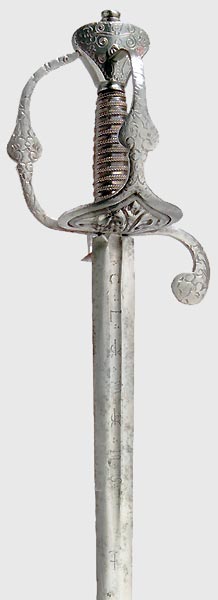
 Attachment: 8.99 KB Attachment: 8.99 KB
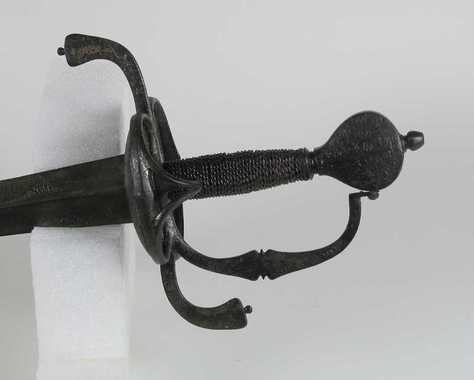
 Attachment: 98.02 KB Attachment: 98.02 KB
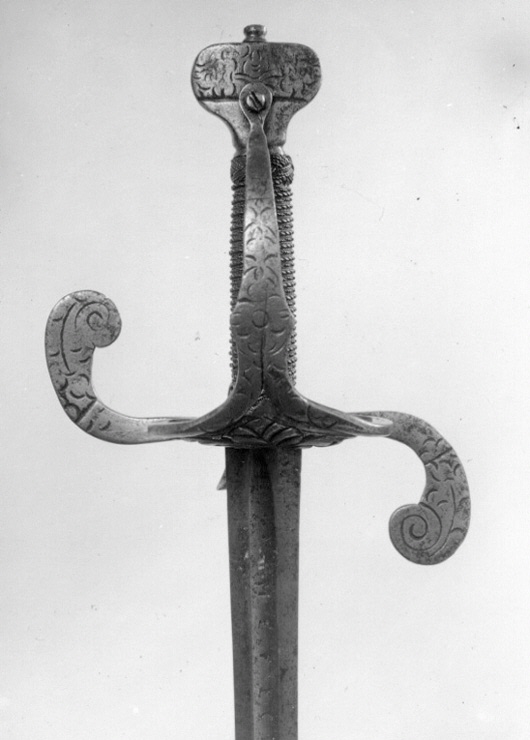
 Attachment: 56.22 KB Attachment: 56.22 KB
[ Download ]
Stephen Wheatley
|
|
  |
 |
|
Kjell Magnusson
|
 Posted: Sat 23 May, 2015 1:46 am Post subject: Posted: Sat 23 May, 2015 1:46 am Post subject: |
 |
|
| Roger Hooper wrote: | | Here is a photo that I found of early 17th century Swedish cut and thrust swords |
They cover a large chunk of the 17th century. Left to right (and according to the museum) those are:
Cavalry sword, probably for an officer, 1620-30.
Sword of Dutch type, the kind that Gustav II Adolf had introduced to the Swedish army, first half of the 17th century.
Cavalry sword, 1630-50.
Infantry sword, mid 17th century.
Sword, 1660-70.
Infantry trooper's sword m/1685.
The m/1685 was manufactured into the 1730's, and replacement with the m/1748 cutlass didn't really take off until the Pomeranian war of 1757-62, with some units still issuing the m/1685 into the 1790's. The navy then took large number of them out of storage, cut down the tip a bit, and adopted the result as the m/1832.
|
|
  |
 |
|
Niels Just Rasmussen
|
 Posted: Sat 23 May, 2015 4:35 am Post subject: Posted: Sat 23 May, 2015 4:35 am Post subject: |
 |
|
| J.T. Aliaga wrote: | Perhaps not bishops depicted but Saints?
Anyhow, I was raised Catholic but I thought some Protestant & Lutheran bishops wore mitres. |
Caveat: It is totally possible, that the depictions on the Øksnebjerg sword are not Bishops at all (The site only gives the picture from one side of the sword), but this following discussion takes the consequences it is a Bishop or could be perceived by others as (catholic) bishops.
As the Thirty Years War was predominately a religious war (though politics and quest for territory also played a large part) it would have been quite hard to imagine a catholic looking sword in a lutheran army and vice versa.
According to Luther the Pope was the anti-christ: [His reply to the Papal bull of Pope Leo X]
"For who before God would be happier than Luther if he were condemned from so great and high a source for such manifest truth? But the cause seeks a worthier martyr. I with my sins merit other things. But whoever wrote this bull, he is Antichrist. I protest before God, our Lord Jesus, his sacred angels, and the whole world that with my whole heart I dissent from the damnation of this bull, that I curse and execrate it as sacrilege and blasphemy of Christ, God's Son and our Lord."
and later....
"The wrath of God is coming upon the papists, the enemies Of the cross of Christ, that all men should resist them. You then, Leo X, you cardinals and the rest of you at Rome, I tell you to your faces: "If this bull has come out in your name, then I will use the power which has been given me in baptism whereby I became a son of God and co-heir with Christ, established upon the rock against which the gates of hell cannot prevail. I call upon you to renounce your diabolical blasphemy and audacious impiety, and, if you will not, we shall all hold your seat as possessed and oppressed by Satan, the damned seat of Antichrist; in the name of Jesus Christ, whom you persecute."
Source: http://law2.umkc.edu/faculty/projects/ftrials...ebull.html
So running around with a papist-looking-weapon in a Lutheran army during the Thirty Years War would be totally comparable to a Catholic running around with a picture of the devil and inscribed pentagrams on his sword. For a lutheran the fight against the papacy and the catholic establishment was a fight with the devil himself.
So all Catholic things (meaning not in the Bible) were denounced: All Lutheran are by definition priests, actual priests and bishops are not holy, but in fact civil servants (at least in the Danish Lutheran Church) as you had to make sure that someone could conduct the correct service. In theory every Lutheran can do it. So it would NOT make any sense to have bishops on your swords for a lutheran (only exception was if the owner was a Lutheran bishop).
Furthermore Lutheranism also denounced all believes in saints as all men are 100% sinners (including Luther and the Virgin Mary). Instead of being cleansed of sin in Purgatory before stepping into heaven a Lutheran is saved by faith alone. If faithful you still go to heaven as 100% sinner and God covers up you sin (not removes it) and declares you righteous as a Judge he is.
Here one of the most famous lines of Luther: "Good works do not make a good man, but a good man does good works; evil works do not make a man wicked, but a wicked man does evil work".
So it is not actions, but ONLY faith that is important for being deemed righteous by God and thus get salvation.
"Only a man of (Lutheran) fate are in fact even able to do good works and evil works doesn't make him wicked since he has fate."
A man that doesn't have faith (non-Lutheran) are not in any way able to be a good man, even if he does good works, since a wicked man (non-Lutheran) does evil work by definition by lack of faith!
That is the reason I find it very unlikely that a papist looking sword (even if it's not by intent it would look so to an observer and thus be very dangerous to carry around) should be carried by some one on Funen in the Thirty Years War.
Later in the war with Sweden 1658-1660 where Denmark then got catholic allies it would certainly had softened up, so it's much more likely that it could be a sword from this period.
Off course Lutheranism have softened up A LOT since then, but in the religious war people took it deadly serious as their salvation depended on it.
Last edited by Niels Just Rasmussen on Sat 23 May, 2015 5:31 am; edited 1 time in total
|
|
  |
 |
|
Niels Just Rasmussen
|
 Posted: Sat 23 May, 2015 5:23 am Post subject: Posted: Sat 23 May, 2015 5:23 am Post subject: |
 |
|
| Mark Millman wrote: | Dear Niels,
| On Wednesday 20 May 2015, you wrote: | | Apparently none of the Walloons in this thread come as close as this swedish Sword to the Øksnebjerg sword. For instance none of them have a flattened pommel OR one ring open, the other semi covered. |
The Øksnebjerg sword originally had two covered rings, but has lost the plate from its outer ring. Plates of this sort typically were inserted into grooves in the inner surfaces of the side rings and held in place only by spring tension. If you look closely at the second photo on the museum page that you cited (the image with the angled close-up view of the hilt), you can clearly see the groove inside the obverse ring.
Best,
Mark Millman |
Astute observation, Mark. You are quite right with the groove.
The question is was it done deliberately or is the result of damage? The Swedish sword sold on the auction in Denmark I showed earlier, doesn't have a groove and neither does one of the swords shown by Stephen (second from the top).
So some of these swords seem to deliberately have one uncovered and one semi-covered ring.
Could be the angle, but on these two swords the uncovered rings seems a bit smaller then the "walloon style" covered ring!
It could mean the Øksnebjerg sword was an older sword being brought up to "current fashion" by removing one of the covers?
I have no idea about function, but sometimes fashion also plays a roll.
|
|
  |
 |
|
Niels Just Rasmussen
|
 Posted: Sat 23 May, 2015 6:23 am Post subject: Posted: Sat 23 May, 2015 6:23 am Post subject: |
 |
|
So went through the pictures of the other swords in the Koldinghus collection. A bit over 200 swords, where the bulk of them are military swords from the 1800's.
It seems though that no expert in older swords has really dealt with this collection (at least not from the info attached to each sword), so I found some others that could be late 1500~1600 dated as examples of possibly Danish sword types of this period.
So here is one called a “middle age rapier" - that is pretty unspecific:
Source: https://www.kulturarv.dk/mussam/VisGenstand.action?genstandId=3915579
It looks a bit like the latest model Tessak (Type F) issued by King Christian IV to Norway (as seen from the other side, that the Arma Dania picture ? - see source just below here)
The tessak being the first officially army issued military swords for Denmark/Norway. As Christian IV mostly relied on foreign mercenaries to fight wars around Denmark, the Norwegian peasant militia didn't have money to supply themselves with swords, so they had to get a cheap offer from the crown.
Source: https://www.arma-dania.dk/public/timeline/_AD_blankvaben_view.php?editid1=226
Tessaks were issued to Norway from 1589 to 1617 (and even if you have models A-F - and a G; no picture - there were a lot of individual variations of the swords). They were bought from Germany and "Central Europe".
This sword was from the private collection of King Frederik VII (1848-1863) and is called a cavalry rapier from around 1600.
Source: https://www.kulturarv.dk/mussam/VisGenstand.action?genstandId=2068765
Has one closed ring and a round pommel and is basket hilted or what you should call it.
Again without being an expert it does look 1600's to me.
This sword was found in a bog at Gamst (Gamst Mose) west of Kolding. It is said to be from the time of Frederik II (1559-1588). It has an two bronze inscriptions made in niello technique: One side PETER MVNSTER and the other ME FECIT SOLINGEN.
Source: https://www.kulturarv.dk/mussam/VisGenstand.action?genstandId=3901011
This sword had two open rings and a crude basket hilt.
As Solingen is very famous - it should be possible to get a date from the sword-smith Peter Munster in some record.
This sword, just said to be from the time of Christian IV (1588-1648).
Source: https://www.kulturarv.dk/mussam/VisGenstand.action?genstandId=2071701
Again two open rings and a fairly crude basket hilt.
Let me know if some of them are special surprising or typical (whatever) for the time period. 
Lastly a sword that is said to be a "cavalry sword" with Ulfklinge (whatever an Ulf-blade is - maybe they mean Passau wolf marking?), iron guard and brass pommel.
Source: https://www.kulturarv.dk/mussam/VisGenstand.action?genstandId=2070278
Is equipped a very old style looking brass pommel. Maybe it is just a sword that is made to look old without being so.
EDIT: This seem definitely to be a later weapon. Typical rapier style from late 1600's to mid 1700's also issued in the Danish army.
Last edited by Niels Just Rasmussen on Sat 23 May, 2015 8:27 am; edited 4 times in total
|
|
  |
 |
|
Niels Just Rasmussen
|
 Posted: Sat 23 May, 2015 6:53 am Post subject: Posted: Sat 23 May, 2015 6:53 am Post subject: |
 |
|
Found a Tessak from Horsens Museum that actually have two rings, one uncovered and one covered, so it do seem to be deliberate: It doesn't really fit any of the Models A-F. They have good info on this sword.
Total Length: 118 cm
Grip: 9 cm
Blade length: 104,5 cm
Pommel: 6*6 cm
Guard: 25 cm slightly turned downwards towards the blade.
Ricasso: 6 cm
Double edged with a thin "blood groove" of 18 cm.
Source: https://www.kulturarv.dk/mussam/VisGenstand.action?genstandId=726701
Found some more information about the Tessak at the Norwegian weapon site:
Source: http://norskevaapen.no/?p=1776
It seems that they were produced somewhere in perhaps Southern Germany and Bohemia in great quantities, but are only really found in great quantities in Switzerland and Norway (and some in Denmark). 400-500 of the 8000 swords brought to Norway still exists.
The Tessak's were earlier mislabeled as "Sinclair Sabers" as they were thought to come from Scottish mercenaries fighting in Norway in 1612.
Also according to the Norwegian site the "Schwedendegen" was made in huge quantities in Germany (likely Passau and Solingen) in 1630-40's.
Called "Schwedendegen" if double edge and "Svensksabel" (Swedish Saber) if single edged.
So named after Sweden, they are in fact German!
Source: http://norskevaapen.no/?p=1846
So the Swedish army used a sword made from a Dutch model turned Gustavian (Swedish), while the Danes and Norwegians used a German model called "Schweden-degen" of the Swedish model of the Dutch model?!
Damn that is complicated  - and maybe the Danes/Norwegian could have made changes to the German model. - and maybe the Danes/Norwegian could have made changes to the German model.
So here is what the Danish auction house (from a Norwegian collection) calls a Norwegian/Swedish Schwedendegen ? [how is that possible - either it is Danish/Norwegian or Swedish/Finnish], but again it is an example with one open ring and one covered. So it seems that this is a "Scandinavian" model.
Source: http://www.bruun-rasmussen.dk/search.do?pg=1&...ode=detail
Also found a Swedish example again with one covered and one open ring from Norrbottens Museum.
It has the Passau wolf mark on the blade and the marking 1414 (clearly not the year, but this marking must give us some production date), but according to experts the sword is NOT made in Passau, but in Solingen.
Source: http://www.norrbottensmuseum.se/arkiv-samling...vaerd.aspx
They say the type was introduced in 1650 - which can clearly not be the case, since this type was in use in the Thirty Years War by Swedish forces.
It must mean that the specifically German model of "Schweden-degen" produced in Passau and/or Solingen came to Scandinavia in 1650's.
Last edited by Niels Just Rasmussen on Sat 23 May, 2015 9:24 am; edited 2 times in total
|
|
  |
 |
|
|
You cannot post new topics in this forum
You cannot reply to topics in this forum
You cannot edit your posts in this forum
You cannot delete your posts in this forum
You cannot vote in polls in this forum
You cannot attach files in this forum
You can download files in this forum
|
All contents © Copyright 2003-2024 myArmoury.com — All rights reserved
Discussion forums powered by phpBB © The phpBB Group
Switch to the Basic Low-bandwidth Version of the forum
|

